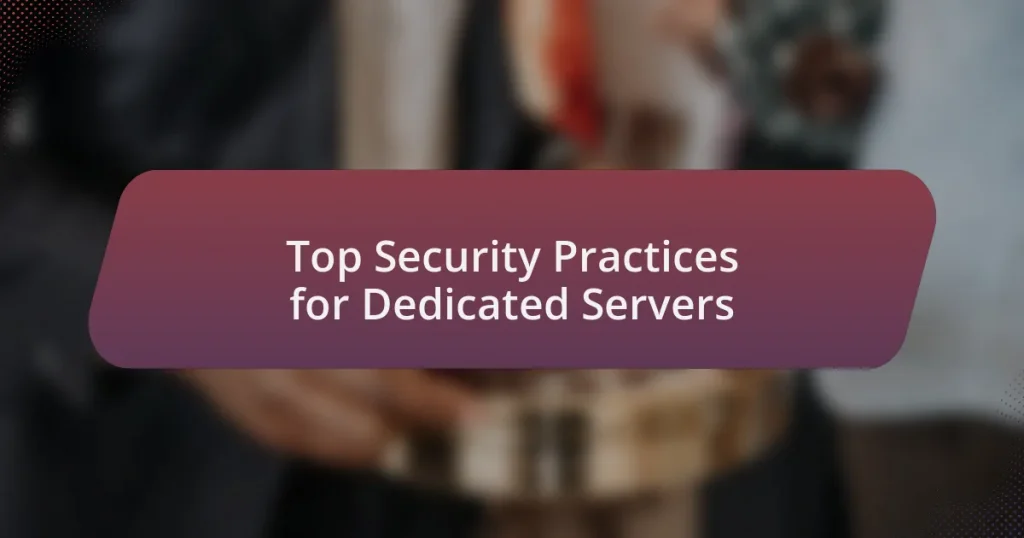The article focuses on the top security practices for dedicated servers, emphasizing the importance of implementing strong access controls, regular software updates, firewalls, and conducting security audits. It outlines the critical risks associated with inadequate security, such as data breaches and unauthorized access, and discusses advanced measures like multi-factor authentication and intrusion detection systems. Additionally, the article highlights the significance of data encryption, effective user access management, and regular monitoring and auditing to enhance server security. Key takeaways include the necessity of a robust backup and recovery strategy to protect against data loss and the importance of staying informed about emerging security threats.
What are the Top Security Practices for Dedicated Servers?
The top security practices for dedicated servers include implementing strong access controls, regularly updating software, using firewalls, and conducting regular security audits. Strong access controls, such as using complex passwords and two-factor authentication, help prevent unauthorized access. Regular software updates patch vulnerabilities, reducing the risk of exploitation. Firewalls act as a barrier between the server and potential threats, while regular security audits identify weaknesses in the system. According to a 2021 report by Cybersecurity Ventures, 60% of small businesses that experience a cyber attack go out of business within six months, highlighting the importance of these security practices.
Why is security crucial for dedicated servers?
Security is crucial for dedicated servers because they host sensitive data and applications that are often targeted by cyber threats. Dedicated servers provide exclusive resources to a single user or organization, making them attractive targets for hackers seeking to exploit vulnerabilities. According to a report by Cybersecurity Ventures, cybercrime is projected to cost the world $10.5 trillion annually by 2025, highlighting the importance of robust security measures. Implementing strong security protocols, such as firewalls, intrusion detection systems, and regular software updates, is essential to protect against unauthorized access and data breaches.
What risks are associated with inadequate security on dedicated servers?
Inadequate security on dedicated servers exposes organizations to multiple risks, including data breaches, unauthorized access, and service disruptions. Data breaches can lead to the theft of sensitive information, resulting in financial loss and reputational damage; for instance, the 2017 Equifax breach compromised the personal data of approximately 147 million individuals. Unauthorized access can allow malicious actors to manipulate server configurations or deploy malware, which can disrupt services and lead to downtime. Additionally, inadequate security measures may result in compliance violations, as organizations may fail to meet regulatory requirements such as GDPR or HIPAA, leading to potential fines and legal repercussions.
How can security breaches impact server performance and data integrity?
Security breaches can significantly degrade server performance and compromise data integrity. When a breach occurs, it often leads to unauthorized access, which can result in resource exhaustion as attackers may deploy malware or conduct denial-of-service attacks, consuming server resources and slowing down legitimate operations. Additionally, data integrity is jeopardized as attackers can alter, delete, or exfiltrate sensitive information, leading to potential data loss or corruption. For instance, the 2017 Equifax breach exposed personal data of 147 million people, highlighting how breaches can lead to severe data integrity issues and operational disruptions.
What are the fundamental security measures for dedicated servers?
The fundamental security measures for dedicated servers include implementing firewalls, using strong authentication methods, regularly updating software, and conducting regular security audits. Firewalls act as a barrier between the server and potential threats, controlling incoming and outgoing traffic based on predetermined security rules. Strong authentication methods, such as two-factor authentication, enhance access control by requiring multiple forms of verification. Regular software updates patch vulnerabilities, reducing the risk of exploitation by attackers. Security audits help identify weaknesses in the server’s configuration and security policies, allowing for timely remediation. These measures collectively strengthen the overall security posture of dedicated servers.
How does implementing firewalls enhance server security?
Implementing firewalls enhances server security by creating a barrier between trusted internal networks and untrusted external networks. Firewalls monitor and control incoming and outgoing network traffic based on predetermined security rules, effectively blocking unauthorized access and potential threats. For instance, according to a report by the Cybersecurity & Infrastructure Security Agency, firewalls can prevent up to 80% of cyber attacks by filtering malicious traffic before it reaches the server. This proactive defense mechanism is crucial for maintaining the integrity and confidentiality of sensitive data hosted on dedicated servers.
What role does regular software updates play in maintaining security?
Regular software updates are crucial for maintaining security as they patch vulnerabilities that could be exploited by attackers. These updates often include fixes for known security flaws, which, if left unaddressed, can lead to unauthorized access, data breaches, or system compromises. For instance, the 2017 Equifax breach, which exposed sensitive information of 147 million people, was largely attributed to the failure to apply a critical security update. By consistently applying updates, organizations can significantly reduce their risk of cyber threats and enhance their overall security posture.
What advanced security practices should be considered?
Advanced security practices for dedicated servers include implementing multi-factor authentication (MFA), regular security audits, and intrusion detection systems (IDS). Multi-factor authentication significantly reduces the risk of unauthorized access by requiring multiple forms of verification, which is supported by studies showing that MFA can block 99.9% of automated attacks. Regular security audits help identify vulnerabilities and ensure compliance with security policies, while intrusion detection systems monitor network traffic for suspicious activity, providing real-time alerts to potential threats. These practices collectively enhance the security posture of dedicated servers, making them more resilient against cyber threats.
How can intrusion detection systems protect dedicated servers?
Intrusion detection systems (IDS) protect dedicated servers by monitoring network traffic and system activities for suspicious behavior or known threats. These systems analyze data packets and logs in real-time, enabling the detection of unauthorized access attempts, malware, and other security breaches. For instance, according to a report by the Ponemon Institute, organizations that implement IDS can reduce the average time to detect a breach by 50%, significantly minimizing potential damage. By alerting administrators to potential threats, IDS allows for timely responses, thereby enhancing the overall security posture of dedicated servers.
What is the importance of data encryption for server security?
Data encryption is crucial for server security as it protects sensitive information from unauthorized access and breaches. By converting data into a coded format, encryption ensures that even if data is intercepted, it remains unreadable without the appropriate decryption key. This is particularly important given that, according to a 2021 report by IBM, the average cost of a data breach is $4.24 million, highlighting the financial and reputational risks associated with inadequate data protection. Furthermore, encryption complies with various regulatory requirements, such as GDPR and HIPAA, which mandate the safeguarding of personal and sensitive data. Thus, implementing data encryption is a fundamental practice for maintaining server security and protecting against potential threats.
How can user access be managed effectively on dedicated servers?
User access can be managed effectively on dedicated servers by implementing role-based access control (RBAC) and regularly auditing user permissions. RBAC allows administrators to assign permissions based on user roles, ensuring that individuals only have access to the resources necessary for their job functions. Regular audits of user permissions help identify and revoke unnecessary access, reducing the risk of unauthorized actions. According to a study by the National Institute of Standards and Technology, organizations that implement RBAC can significantly decrease security breaches related to user access mismanagement.
What are the best practices for creating strong user passwords?
The best practices for creating strong user passwords include using a minimum of 12 characters, incorporating a mix of uppercase and lowercase letters, numbers, and special symbols. These elements significantly increase the complexity of passwords, making them harder to crack. Research indicates that longer passwords are exponentially more secure; for instance, a 12-character password can take billions of years to crack using brute force methods. Additionally, avoiding common words, phrases, or easily guessable information, such as birthdays or names, further enhances password strength. Implementing unique passwords for different accounts prevents a single breach from compromising multiple services. Using password managers can help users generate and store complex passwords securely, ensuring adherence to these best practices.
How does role-based access control improve security?
Role-based access control (RBAC) improves security by restricting system access to authorized users based on their roles within an organization. This method minimizes the risk of unauthorized access and data breaches by ensuring that individuals can only access information and resources necessary for their job functions. According to a study by the National Institute of Standards and Technology (NIST), implementing RBAC can significantly reduce the attack surface by limiting user permissions, thereby decreasing the likelihood of insider threats and accidental data exposure.
What are the common vulnerabilities in dedicated servers?
Common vulnerabilities in dedicated servers include misconfigured security settings, outdated software, and inadequate access controls. Misconfigured security settings can expose servers to unauthorized access, while outdated software may contain known exploits that attackers can leverage. Inadequate access controls can lead to unauthorized users gaining access to sensitive data or system functionalities. According to a report by the Ponemon Institute, 60% of data breaches are linked to misconfigured security settings, highlighting the critical need for proper configuration and regular updates to mitigate these vulnerabilities.
How can outdated software expose servers to threats?
Outdated software can expose servers to threats by lacking the latest security patches and updates that protect against vulnerabilities. When software is not regularly updated, it becomes susceptible to known exploits that attackers can leverage to gain unauthorized access, deploy malware, or disrupt services. For instance, a study by the Ponemon Institute found that 60% of data breaches involved unpatched vulnerabilities, highlighting the critical importance of maintaining up-to-date software to safeguard server integrity and data security.
What are the implications of weak network configurations?
Weak network configurations can lead to significant security vulnerabilities, exposing systems to unauthorized access and data breaches. These vulnerabilities arise from misconfigured firewalls, inadequate encryption protocols, and poorly managed access controls, which can allow attackers to exploit weaknesses in the network. For instance, a study by the Ponemon Institute found that 60% of organizations experienced a data breach due to misconfigured security settings. Consequently, weak network configurations not only compromise sensitive information but also result in financial losses and damage to an organization’s reputation.
How can monitoring and auditing enhance server security?
Monitoring and auditing enhance server security by providing continuous oversight and analysis of server activities, which helps in identifying and mitigating potential threats. Continuous monitoring allows for real-time detection of unusual behavior, such as unauthorized access attempts or abnormal traffic patterns, enabling swift responses to security incidents. Auditing, on the other hand, involves reviewing logs and records to ensure compliance with security policies and to identify vulnerabilities or breaches that may have occurred in the past. According to a study by the Ponemon Institute, organizations that implement effective monitoring and auditing practices can reduce the average time to detect a data breach by 27%, significantly minimizing potential damage.
What tools are available for monitoring server security?
Tools available for monitoring server security include intrusion detection systems (IDS) like Snort, security information and event management (SIEM) solutions such as Splunk, and vulnerability scanners like Nessus. These tools provide real-time monitoring, log analysis, and vulnerability assessment, which are essential for maintaining server security. For instance, Snort can analyze network traffic for suspicious activity, while Splunk aggregates and analyzes security data from various sources, helping organizations identify potential threats quickly. Nessus, on the other hand, scans for known vulnerabilities, allowing administrators to address security weaknesses proactively.
How often should security audits be conducted?
Security audits should be conducted at least annually. Regular audits help identify vulnerabilities and ensure compliance with security standards. According to the National Institute of Standards and Technology (NIST), organizations should perform security assessments at least once a year to maintain an effective security posture and adapt to evolving threats.
What are the best practices for backup and recovery?
The best practices for backup and recovery include implementing a 3-2-1 backup strategy, which involves maintaining three copies of data, storing two copies on different storage media, and keeping one copy offsite. This approach minimizes the risk of data loss due to hardware failure, natural disasters, or cyberattacks. Regularly testing backup restoration processes is also crucial to ensure data integrity and accessibility when needed. According to a study by the Ponemon Institute, 70% of organizations that regularly test their backups report higher confidence in their recovery capabilities. Additionally, automating backup schedules and using encryption for sensitive data during storage and transfer further enhance security and reliability in backup and recovery practices.
How can regular backups protect against data loss?
Regular backups protect against data loss by ensuring that copies of data are stored securely and can be restored in case of accidental deletion, hardware failure, or cyberattacks. This practice minimizes the risk of permanent data loss, as it allows users to revert to the most recent backup version. According to a study by the National Cyber Security Alliance, 60% of small businesses that experience data loss close within six months, highlighting the critical importance of having a reliable backup strategy in place.
What strategies should be implemented for effective disaster recovery?
Effective disaster recovery strategies include creating a comprehensive disaster recovery plan, regularly backing up data, and conducting routine testing of recovery procedures. A comprehensive disaster recovery plan outlines the steps to take during a disaster, ensuring that all stakeholders understand their roles and responsibilities. Regular data backups, ideally stored offsite or in the cloud, protect against data loss and facilitate quick restoration. Routine testing of recovery procedures ensures that the plan is effective and identifies any gaps or areas for improvement, which is critical as systems and technologies evolve. According to a study by the Disaster Recovery Preparedness Council, organizations with a documented disaster recovery plan are 50% more likely to recover from a disaster successfully.
What practical tips can enhance security for dedicated servers?
To enhance security for dedicated servers, implement strong access controls, including the use of complex passwords and two-factor authentication. Strong access controls prevent unauthorized access, significantly reducing the risk of breaches. According to a 2020 report by Verizon, 81% of hacking-related breaches leveraged stolen or weak passwords, highlighting the importance of robust password policies. Additionally, regularly updating software and applying security patches is crucial, as 60% of breaches involve known vulnerabilities that could have been mitigated through timely updates. Firewalls and intrusion detection systems should also be employed to monitor and filter incoming and outgoing traffic, providing an additional layer of security against potential threats.
How can server administrators stay informed about security threats?
Server administrators can stay informed about security threats by subscribing to cybersecurity news feeds, utilizing threat intelligence platforms, and participating in professional forums. Cybersecurity news feeds provide real-time updates on vulnerabilities and exploits, while threat intelligence platforms aggregate data on emerging threats, helping administrators assess risks. Additionally, engaging in professional forums allows administrators to share experiences and insights with peers, enhancing their understanding of current security challenges. These methods collectively ensure that server administrators remain vigilant and proactive in addressing potential security threats.
What are the key takeaways for maintaining a secure dedicated server environment?
To maintain a secure dedicated server environment, implement strong access controls, regularly update software, and utilize firewalls. Strong access controls, such as using complex passwords and two-factor authentication, prevent unauthorized access. Regular software updates patch vulnerabilities, reducing the risk of exploitation; for instance, a 2020 report by the Cybersecurity and Infrastructure Security Agency indicated that 60% of breaches involved unpatched vulnerabilities. Firewalls act as a barrier between trusted internal networks and untrusted external networks, monitoring and controlling incoming and outgoing traffic based on predetermined security rules. These practices collectively enhance the security posture of dedicated servers.










